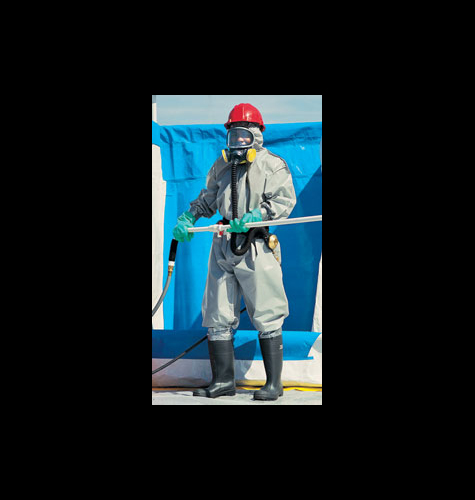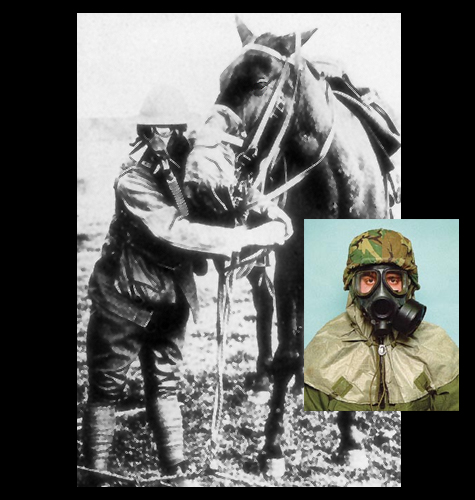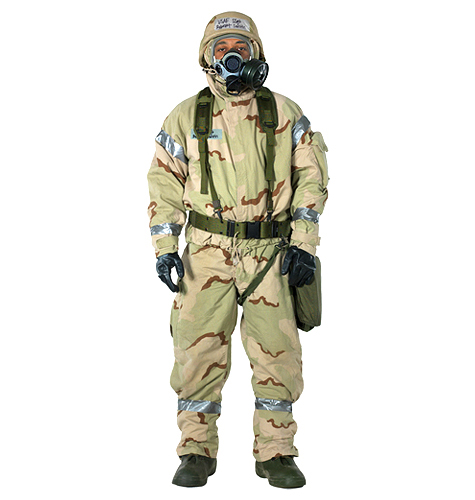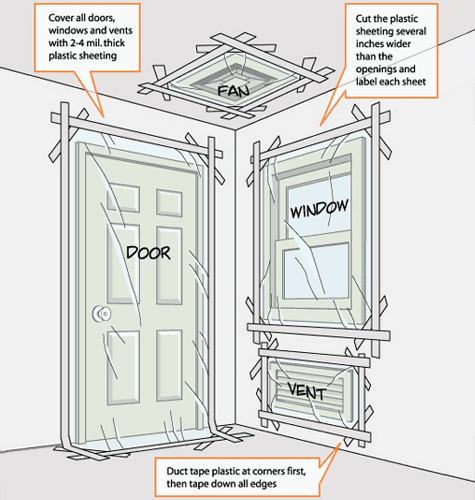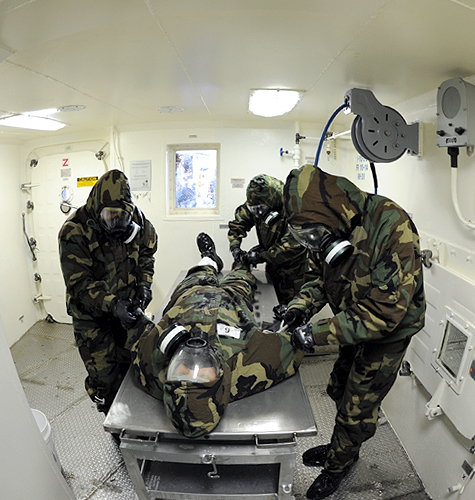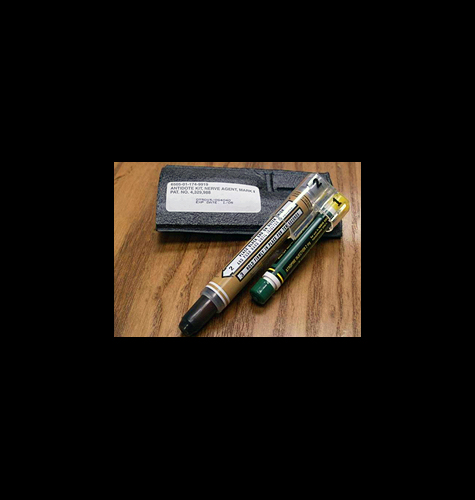How do states develop and test chemical weapons?
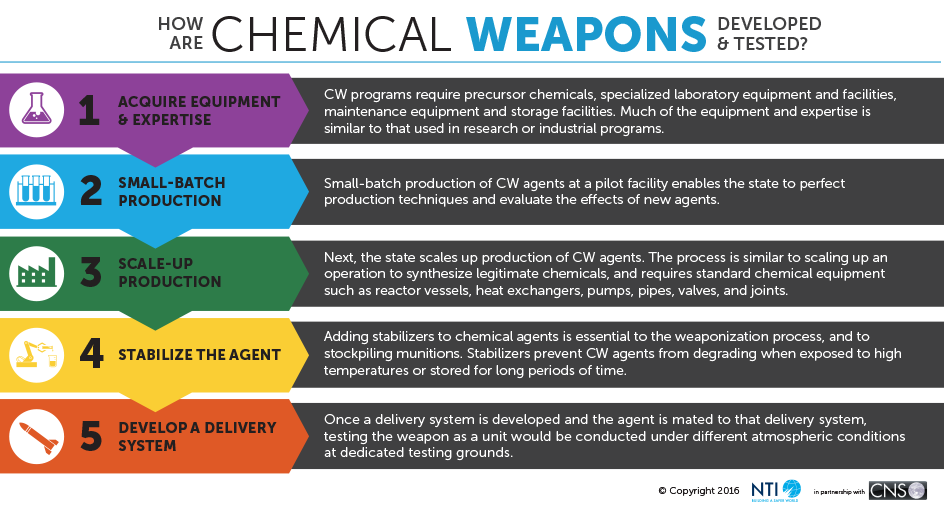
![]()
1. Acquire Equipment and Expertise
CW programs require precursor chemicals, specialized laboratory equipment and facilities, maintenance equipment and storage facilities. Much of the equipment and expertise is similar to that used in research or industrial programs.
![]()
2. Small-Batch Production
Small-batch production of CW agents at a pilot facility enables the state to perfect production techniques and evaluate the effects of new agents.
![]()
3. Scale-Up Production
Next, the state scales up production of CW agents. The process is similar to scaling up an operation to synthesize legitimate chemicals, and requires standard chemical equipment such as reactor vessels, heat exchangers, pumps, pipes, valves, and joints.
![]()
4. Stabilize the Agent
Adding stabilizers to chemical agents is essential to the weaponization process, and to stockpiling munitions. Stabilizers prevent CW agents from degrading when exposed to high temperatures or stored for long periods of time.
![]()
5. Pair with Delivery System/Test
Once a delivery system is developed and the agent is mated to that delivery system, testing the weapon as a unit would be conducted under different atmospheric conditions at dedicated testing grounds. [1]
How difficult is it for states to acquire chemical weapons?
- A state with a sophisticated chemical sector could acquire chemical weapons with relative ease. Producing chemical weapons is less technologically demanding than producing nuclear or biological weapons.
- The level of difficulty for each step in the process will vary depending on the type of agent produced and the level of sophistication the state is attempting. If a state is trying to produce the simplest CW agents and to weaponize and deliver them using the most basic options available, each step in the process would be fairly easy. [2]
Key Requirements for Chemical Weapons
| Basic chemical precursors needed to produce CW agents are widely available commercially. Some nerve agent precursors are not available but could be indigenously produced. | |
| University-level knowledge of organic chemistry and chemical engineering is widely available and design information is ample in the academic literature. However, some engineering processes are complex, and new state programs might have difficulty acquiring expertise on them if they do not have direct assistance from foreign experts. Failure to master engineering processes may reduce the quality of synthesized agents. | |
| Handling toxic chemicals requires specialized equipment for quality control and to adequately ensure personnel safety. Much of the equipment needed for producing toxic chemical agents has legitimate applications for industrial use and is widely available. Special containment equipment may be difficult to assemble but may not be necessary for production. | |
| A dedicated chemical production plant is not difficult to build or operate. Converting existing commercial chemical plants to produce toxic chemical agents is possible, but may require some specialized skills. | |
| It is relatively inexpensive to produce small batches of chemical agents. The cost to produce hundreds of tons of nerve agents for a significant military capability would likely be tens of millions of dollars. As new technologies and processes are developed in the future, the per unit cost of production will likely decrease. | |
| Workable munitions designs are widely published, but advanced weapons for nerve agents and binary weapon designs are difficult to produce even with design information, as they require a high degree of experience-based expertise. |
Can chemical weapons be stockpiled for later use?
Yes. During the Cold War the United States and the Soviet Union successfully stockpiled tens of thousands of tons of CW agents. However, it is not an easy task:
- Unless chemical agents are produced for immediate use, they must be distilled to achieve high purity levels and stabilizers must be added to prolong their shelf-life. [3] Both tasks can be extremely hazardous and may present significant technical hurdles.
- Developing binary, as opposed to unitary, munitions can also enhance the stability of chemical weapons, thereby making them easier and safer to store and transport. [4] More stable, binary munitions require more advanced engineering capabilities.
Binary Munition

Binary munitions contain two separate canisters filled with relatively non-toxic precursor chemicals. Once the fuse ignites, it detonates a burster, which causes the first precursor canister to break a separator, or burster plate, and crash into the second precursor canister. The two precursors then react to produce a lethal chemical agent.
Unitary Munition

Unitary chemical munitions are filled with agents at a loading facility before being stored and transported. A fuse is the only thing needed before use.
Below is a rotatable annotated model of a chemical munition.
How are chemical agents delivered to a target?
Chemical agents can be delivered to a target through a variety of methods, usually categorized by how they disperse the agent. Delivery methods fall into two broad categories: point sources and line sources.
- Point source delivery involves dispersing an agent from a single location. Point source delivery systems include grenades, mines, artillery shells, and warheads delivered via missiles.
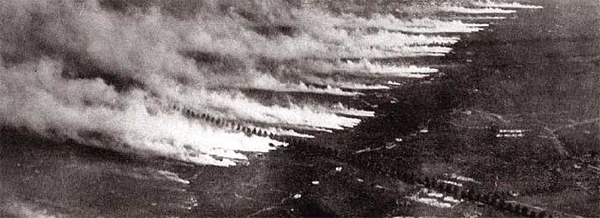
Gas Attack Viewed from an Airplane, Source: WikiMedia Commons
During the Cold War, the United States equipped the Honest John missile with a warhead containing “bomblets” filled with sarin. The Soviet Union also produced ballistic missile delivery systems for CW agents, including the Scud-C variant.
Below is a rotatable annotated model showing how a missile can be used to deliver chemical weapons, in this case sarin bomblets.
- Line source delivery involves dispersing an agent from a moving source that can cover a much larger area than point source delivery would. Line source delivery systems include sprayers attached to moving vehicles or aircraft.
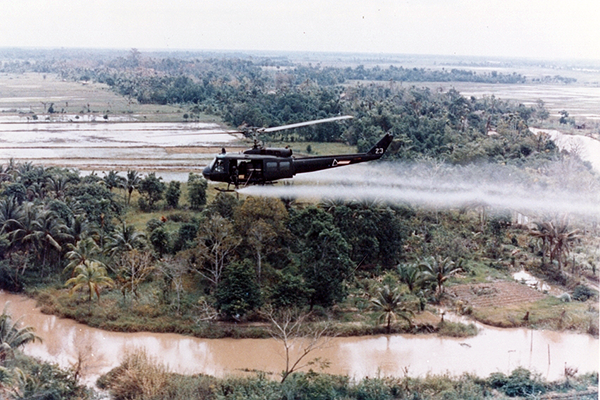
Helicopter Spraying Agent Orange, Source: U.S. Army via WikiMedia Commons
Are there effective defenses or antidotes to counter chemical weapons use?
It depends on the agent used. If adequate defensive measures can be taken, these are generally preferable to and more effective than antidotes. Antidotes only exist for some types of CW, cannot undo damage that has already been done, and are only effective in preventing further damage if administered promptly after exposure. [5]
Sources
[1] U.S. Office of Technology Assessments, Technologies Underlying Weapons of Mass Destruction- Technical Aspects of Chemical Weapon Proliferation, (1993), pp. 12-13, http://fas.org/spp/starwars/ota/934404.pdf; and Eric Croddy, Chemical and Biological Warfare: A Comprehensive Survey for the Concerned Citizen, (New York: Springer-Verlag, 2002).
[2] U.S. Office of Technology Assessments, Technologies Underlying Weapons of Mass Destruction- Technical Aspects of Chemical Weapon Proliferation, (1993), pp. 12-13, http://fas.org/spp/starwars/ota/934404.pdf.
[3] U.S. Office of Technology Assessments, Technologies Underlying Weapons of Mass Destruction- Technical Aspects of Chemical Weapon Proliferation, (1993), p. 58, http://fas.org/spp/starwars/ota/934404.pdf.
[4] U.S. Office of Technology Assessments, Technologies Underlying Weapons of Mass Destruction- Technical Aspects of Chemical Weapon Proliferation, (1993), p. 34-35, http://fas.org/spp/starwars/ota/934404.pdf.
[5] “Protective Equipment,” The Organization for the Prohibition of Chemical Weapons, www.opcw.org; The Organization for the Prohibition of Chemical Weapons, “A Day in the Life of an Inspector,” https://www.opcw.org/fileadmin/OPCW/PDF/Life_as_an_Inspector_for_Group_M_2013.pdf; “The Emergency Response Safety and Health Database,” U.S. Centers for Disease Control, www.cdc.gov.
Photo Credits
Header Image: Empty casings after being thermally decontaminated. Source: U.S. Army Chemical Materials Agency via WikiMedia Commons.
